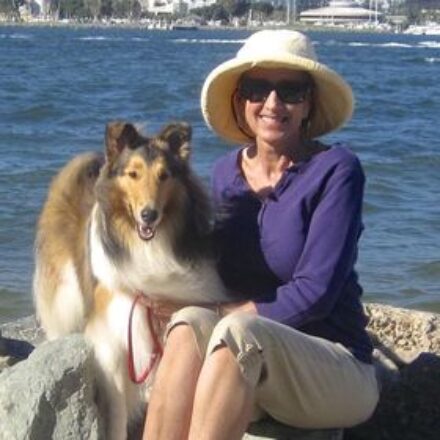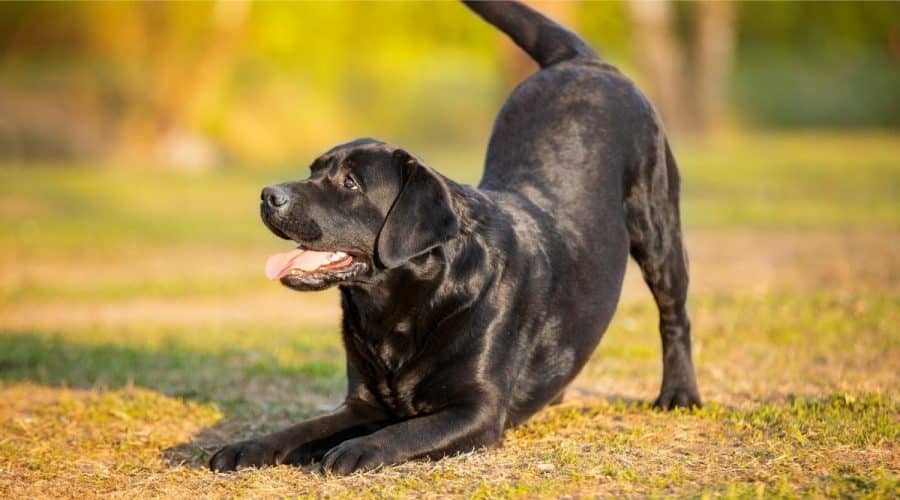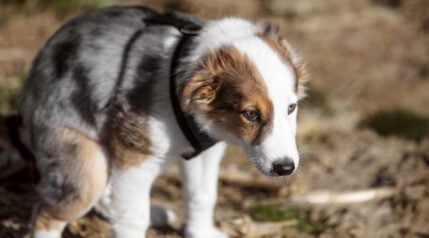Seeing how your dog reacts to learning different types of tricks can be one of the most rewarding experiences of owning a dog. Not all dogs learn at the same pace, so you’ll need to be patient and persistent when you conduct your training. Make sure your dog is old enough to start training and knows their name.
In the 27 videos below, we have Jan training her Collie named Bonnie. Collies are notoriously smart dogs and can learn tricks rather quickly. Kelly’s Mastiffs both learn tricks much slower and need constant reinforcement. Jan has many years of dog training experience with her pups, so don’t expect the same results right away. Keep in mind that some dog tricks are easier than others. Start simple, and save the cooler and harder ones for later.
Regardless of what type of dog you have, here are some of our favorite tricks you can teach them. We’d recommend focusing on one trick at a time until your dog masters that trick before moving on to the next one. Let’s get started on learning some of the top dog tricks you can teach your sweet pup.
You could also try an online dog trainer like Doggy Dan for an affordable solution that fits your schedule.
Shake Hands
Start by having your dog sit. Say, “Shake hands,” and take his paw with your hand. Hold his paw and say, “Good dog” Let go of his paw. Do this a few times every day.
After a while, say, “Shake hands,” but don’t take his paw. See if he raises his paw by himself. If not, keep showing him what to do by saying, “Shake hands,” and taking his paw with your hand. Your dog is not slow; he is just learning.
Shake is one of the easiest tricks to learn, so it’s good to teach dogs that are fast learners and dogs that are also stubborn, like the Rottweiler.
Cross Your Paws
I love to teach tricks because it’s fun and stimulating for dogs and helps them understand what learning is all about. Showing off a new trick is good entertainment for family and friends and is a way for people to find a connection with your dog. Instead of greeting a guest at the door by jumping up, isn’t it better to have a dog sit and give a high five?
Some breeds are more popular with families, and these breeds are generally some of the breeds that are faster to learn obedience and basic tricks.
There are the standard tricks that I have always been taught, but I like to try a new one once in a while. ‘Cross Your Paws’ is a trick that took me a little while to teach Bonnie. Before beginning, I broke it into several steps. As Bonnie became successful with each step, I moved on to the next one.
This is a really fun trick. I’m having a good time with it. When Bonnie is bored and looking around for something to do, all I have to do is let her go through her list of tricks. She gets a treat or two, lots of praise, and big hugs.
Double Cross Paws
Here are the standard dog tricks I have always taught, but I occasionally like to try a new ones. ‘Cross Your Paws’ is a trick that took me a while to teach Bonnie. After she learned it really well, I decided to take it a little further and expand the trick to the Double-Cross.
Before you start, make sure your dog has learned the first Cross Your Paw trick. Then teach her to do the Double-Cross exactly the same way you taught the Cross Paw trick, this time using the other paw. Your dog will probably understand this trick much easier this time around.
Fetch
If your dog doesn’t fetch naturally, have an adult cut a slit in a tennis ball (a smaller rubber ball if that is too big). Put some treats inside the tennis ball. Show your dog that there are treats in there, and give her one. Then, throw the ball. In the beginning, run with her and get the ball. Then give her the treat. Soon you will be able to throw the ball, and she will go get it (because she wants the treat).
After your dog has figured out what he has to do to get a treat, start throwing the ball two times in a row without giving him the treat. You are trying to give him the treats less and less often so that someday he won’t need the treats in the ball to fetch it.
Yawn
Every time you see your dog yawn, say the command you want to use, like “Give us a yawn” or “Are you sleepy?” If he yawns enough and hears those words enough, he will eventually yawn whenever he hears those words.
Here’s one of those tricks your dog has to perform before learning it. Hopefully, you have a dog that yawns a lot. Be patient. This one can take a long time. Be sure to praise your pup when he yawns – he’ll think he’s doing something wonderful. And eventually, he will be.
Which One
First, put a treat in one hand, show your dog, and then close both of your hands, making two fists. Hold your fists in front of you, about six inches apart, and say, “Which one?” Your dog will try to pry at your fists with his mouth to find the treat but don’t open your hands. Wait until he tries to use his paw (he will if you wait long enough), let him touch the correct hand, and then give him the treat.
If you have tried this several times, but your dog still won’t use his paws to touch your hand, let him use his mouth to point out the correct hand. It’ll be just as good, and your audience will love the trick just as much.
Come
Have your dog sit in front of you. Using a dog whistle from your local pet store, blow it once and give your dog a treat. Do this several times and repeat it several times during the day. Repeat this over several days, trying it at increased distances. Your dog should soon run to you whenever he hears the whistle.
Use a small but tasty treat, one that your dog really loves. After your dog comes to you from different areas in the house, move outside to fenced areas only. When you notice your dog is a little distracted, blow the whistle and see if he comes. By now, he should come. If not, go back to shorter distances without distractions and take the steps a bit slower.
Teaching a proper recall command is one of the first things you should teach your dog to ensure that they don’t engage in stubborn or harmful behavior. It might take more patience if you have a stubborn dog like a Caucasian Shepherd or an English Bulldog.
Dig (Find The Treasure)
‘Find the treasure’ means the dog will use one or two front paws to dig at the ground. Here’s one way to teach it on command. Gather some treats and put them under a towel while your dog is watching closely. Don’t let your dog use his nose to get under the towel.
Keep encouraging him verbally and showing him that there are treats under the towel. Eventually, he’ll start pawing at the towel. As soon as he moves that paw just a little, say, “Find the treasure” Reward your dog immediately with a treat from your hand or even from under the towel.
For dogs that are not natural diggers, this may take a while. Remember that you’re looking for that digging behavior. You can give him treats under the towel or your hand as encouragement. If he happens to uncover a treat by himself, then praise.
Caution: If you have a dog that digs in the garden and causes trouble because of his digging, you might not want to encourage this behavior.
Ring A Bell
I have to admit that Bonnie was a breeze to housebreak. From the day we got her at fourteen weeks of age, she knew where the back door was and gave a gentle scratch on the screen when she needed to go out. Collies are usually very easy to housebreak, and this was certainly the best experience ever.
However, as she grew, her feet became bigger and stronger, and she began to tear a hole in our screen door. If we closed the glass door so she couldn’t reach the screen, she would slap the glass with her paw. She would scrape her teeth on the glass if that didn’t work for her. The sound was too horrible to bear. I had to come up with a good way for Bonnie to let us know when she needed to go outside without hurting our ears.
I decided to teach Bonnie to ring a bell when she wanted to relieve herself or go outside. First, I taught her the Touch trick. Second, I hung a bell in front of my hand and had her touch it.
Last, I moved the bell to the door and had her touch the bell without my hand in front of it. The video should make it fairly easy to follow. But be sure to teach your dog the Touch trick first. It should make the trick a lot easier.
Pick Up A Cane
Bonnie learned to pick up a bucket last fall. It was Halloween time, and kids were carrying around those black and orange buckets, asking for goodies from friendly neighbors. I thought it would be cute if I taught her to grab the bucket by the handle and bring it to me as if she were trick-or-treating. It was a fun trick, and Bonnie learned it over the course of a couple of weeks.
Once she learned that, she began to pick up other things and bring them to me. It didn’t take long for her to bring me toys and towels. The other day, I was sitting in a chair, and my cane fell to the floor. Bonnie must have thought I was playing the pickup game again because she walked over to it, picked up the cane, and handed it to me. I was astonished. What a smart dog.
Now Bonnie brings me the cane whenever I drop it or if it’s where I can’t get it. I never thought tricks could come in so handy. What a great thing for Bonnie to help me with.
Turn Around
Start by having your dog stand up facing you. Let your dog see a treat in your hand. Stand still and say, “Turn around.” Lead the dog’s nose around to the left (clockwise) with the treat, so he walks in a circle. When he comes back to where he’s facing you again, say, “Good dog!” and give him the treat.
After some practice, hold the treat in front of you so your dog can see it and say, “Turn around,” but don’t lead his nose. See if he is ready to turn around by himself and get the treat. Pretty soon, he will turn around faster than you can say ‘Lassie!”
If you choose to use the words “Turn Left,” use them all the time. Don’t use “Turn around” sometimes and “Turn Left” other times. Be consistent.
This is a great trick for smaller dogs, like the black Pomeranian or the Chigi, because it doesn’t require any size to complete the trick.
Play The Piano
If your dog prefers to play the piano with her nose, that’s ok. Just reward her for doing it. If you prefer that she play with her paws, reward her for that. Just be as consistent as you can so that your dog doesn’t get confused.
I bought the piano at a local toy store. Many dog owners also use toy keyboards for their dogs. Good luck and have fun. Since this trick is more complex, it’s best reserved for dogs that are quick learners, like the German Shepherd Dog.
Wave
Your dog should know how to shake hands before learning this trick. Face your dog and hold out your hand as if you are going to shake. When your dog lifts her paw to shake, don’t grab it. Just pull back your hand, and say, “Wave.” Then give your dog a treat.
At first, your dog may not lift her paw very high. But once she realizes that you’re going to give her a treat if she holds it up there, she’ll get it. You may have to tease her a little with your hand so she thinks you are going to shake with her. Waving your hand a little may help get her paw into a waving motion.
Carry A Bucket
Bonnie and I have been working on a new trick for a while now. She has a natural ability to fetch, so I’ve been encouraging her to chase balls, pick them up, and bring them to me. I also decided I wanted her to learn to pick up other things around the house.
Several months ago, I began teaching Bonnie to carry a bucket. We worked on it a little at a time, a few times a week. At first, she wasn’t even interested in touching the plastic handle, so I started by putting peanut butter on it. Once Bonnie became comfortable with putting her mouth on the handle, the trick became easier. Watch the video to see how Bonnie learned to pick up and carry the bucket. It’s a trick she really likes, and it has led to other tricks that we’ll show you at another time.
High Five
I have always enjoyed teaching my dogs to do tricks. I can do it for a short time whenever I have a few minutes with nothing to do.
‘High Five’ is a trick I’ve never taught before my dog Bonnie, but I’ve seen dogs do it and read instructions on how to do it. It always seemed like it would be fairly easy to do, but I had never tried it. So now it was time to try it with Bonnie.
She learned the trick quickly. I had taught her to shake hands when she was three months old, so she is used to giving us her paw. I decided to have her use the other paw for the ‘High Five.’
I’ve made a short video of Bonnie learning the ‘High Five.’ Can your dog do a ‘High Five’?
Speak & Quiet
Choose a game that your dog loves to play, like catching a ball, or hide and seek with a toy. Then get him excited by saying, “Let’s play! Want to play?” and show him the ball or toy. Jump and act silly, so he barks and then says, “Good dog, speak!” Then play the game as his reward for learning “Speak.”
You can’t make a dog bark, but you can get him happy and excited so he wants to bark. After a while, your dog will bark when you say, “Speak.”
Caution: If you have a dog that already causes trouble because of his barking, you might not want to encourage this behavior. If you decide it’s ok to teach it, be sure to teach “Quiet,” too.
Teaching “Quiet”: This is easiest if your dog already knows how to speak. It’s probably better for older dogs and less so for younger puppies.
Tell your dog to Speak or catch him when he is barking. Get right in front of him and say, “Quiet.” The second he stops, even if it is to take a breath, give him a treat. You might want to hold your hand or palm in front of his face to add a visual signal. Practice playing ‘quiet’ often, and your dog will love the word “Quiet.”
As you teach your dog Quiet, gradually increase the quiet time from 2 seconds to 5 seconds or more. Then, when he understands the trick, you can make a game of it. Tell him to “Speak,” “Speak,” “Speak,” and then “Quiet.” Then “Speak” again. It’s a great trick to entertain your friends, and your pup will look super smart.
Retrieve A Tissue
As most of you know, I’m very big on tricks. I think they are one of the best ways to teach a dog to learn and have fun at the same time. Even young puppies can learn tricks.
Once a dog has learned how to retrieve, he or she is capable of learning all kinds of fetching tricks. When Bonnie was young, we played fetch with a ball. Later she played fetch with toys. We played it a lot, and before long, it became a very special game for Bonnie.
Next, I taught her to pick up a bucket by holding the handle in her mouth. It was the first thing that tasted different than a ball or a toy. From there, I was able to teach Bonnie to carry the bucket. Later she picked up towels and brought them to me. I always rewarded Bonnie when she brought things to me. Now she brings me the remote control, the telephone, and my slippers. To Bonnie, this is a fantastic game. To me, it’s fun and useful. I can tell her to help me by bringing me things.
So next, I taught Bonnie to retrieve a tissue. A tissue tastes very different than anything else she has put in her mouth. But because I had rewarded Bonnie for giving me the items instead of spitting them out or chewing on them, she quickly learned to grab the tissue and gave it to me.
The trick was easy because Bonnie had learned to retrieve all the other things. Now I can ask Bonnie to give my house guest a tissue. It’s a great trick, and it makes people laugh. And if they sneeze, she can help them with that, too.
Jump Through Hula Hoop
If your dog is concerned about going through the hoop, hold a treat and lure him through. Keep the hoop on the ground until he is very confident going through. Then you can begin to raise it. Don’t rush results. Patience will pay off.
Teaching the jump through the hoop technique can be good to ensure your dog doesn’t start jumping in other ways.
Crawl
One of my favorite tricks has always been the ‘crawl.’ Bonnie learned the crawl over a period of weeks and now has a really smooth and comfortable trick to share with friends.
I started out by having Bonnie lie down while I was on the ground next to her. Then, holding a treat in front of her nose, I moved the treat away from her so that she would follow it while staying on the ground. Most dogs try to get up to retrieve the treat, and Bonnie does as well. When she lifted her rear end, I gently tapped it and showed her to put it back down on the ground. Out of a desire for the treat, she scooted just slightly forward. As soon as she did, I praised her wildly and gave her the treat. She had just crawled a tiny bit. We practiced this over and over for two or three minutes a couple of times each day.
The hardest part of teaching a dog to crawl is the transition you have to make from sitting on the ground to standing next to your dog. Here’s how I did it. I found a yardstick. Then I taped a small plastic cup to the very bottom of the stick. I put several pieces of tasty treats in the cup.
Then, while standing, I held the yardstick in front of Bonnie’s nose and coaxed her to crawl. Once she was used to crawling with my standing up, she became comfortable crawling in any situation. Check out Bonnie’s video. I think you’ll see that crawling is a trick that you can teach your dog without too much trouble with this method.
This is another great trick for fast learner dogs, like the Poodle Bernese Mountain Dog Mix.
Beg
Have your dog sit facing you. Hold his favorite treat just above his head and tell him, “Say please.” Your dog will probably lift his front feet off the ground to reach the treat. As soon as the feet are lifted, even a little bit, give him the treat.
This is a hard trick for most dogs. Wait a little longer each time before giving the treat, but be careful not to let your dog fall over on his back. You are helping your dog develop his balance. Be kind and only do this a couple of times.
Take A Bow
TIP: Tricks like this work because you put words with something your dog does. It may take some dogs longer than others to figure this one out. Some dogs learn it in a week and some take years…yes, years! But one day you will say, “Take a bow,” and maybe, just maybe, your dog will take a bow.
Method 1: When you see your dog take a big stretch with his head down low, say, “Take a bow.” Every time he wakes up and stretches, says, “Take a bow.” Someday you will say, “Take a bow.” and your dog will take a big stretch, but it will look like he is bowing. As soon as he is finished, give him the treat.
Method 2: With your dog in a stand position, take a treat and hold it near the floor, under his nose. As your dog reaches down to get it (he may try to lie down), slip your hand under his belly to hold his rear end up. Hold him in that position and say, “Take a bow.” Keep the treat right by his nose, but don’t feed him. Stay there for just a second, release him, and then feed the treat.
TIP: If you feed your dog the treat while he is in the bowing position, in the future he won’t bow until he sees the treat in your hand. If he learns that the treat comes later, he’ll be willing to perform for you without it right there all the time.
Go Back
This is an easy one! Stand facing your dog, and as you walk toward him, say, “Go Back.” He will want to get out of the way and will automatically walk backward.
If your dog doesn’t walk back in a straight line, practice up against a wall or in a narrow hallway. After your dog is walking backward with you, try walking toward him only a step or two. Eventually, you will be able to stand still and say, “Go Back.”
Twirl
Don’t teach two tricks together that are similar. Teaching ‘Turn Around’ and ‘Twirl’ at the same time will confuse your dog.
If the command ‘Twirl’ doesn’t sound natural to you, use what a lot of people choose: ‘Go Right.’ The choice of commands is totally up to you. When you teach ‘Turn Around’ as a separate trick, you can say ‘Go Left’ if that works for you.
“Twirl” is the same trick as “Turn Around” (see above), but this time your dog turns to the right (counterclockwise) instead of to the left.
Start by having your dog stand up facing you. Stand still and say, “Twirl.” Lead the dog’s nose around to the right with the treat so he walks in a circle. When he comes back to where he’s facing you again, say, “Good dog!” and give him the treat.
If you choose to use the words “Turn Right,” use them all the time. Don’t use “Twirl” sometimes and “Turn Right” other times. Be consistent.
After your dog has learned “Turn Around” (or Turn Left) and “Twirl” (or Turn Right), you can put them together and have your dog look really smart. First, have your dog “Turn Around” (turn to the left), and then say “Twirl” (turn to the right). Be careful, though, don’t get your dog dizzy!
Be sure to teach Turn Around and Twirl separately. Wait until your dog has learned the first one very well.
Go To Bed
“Go to bed” means go to bed AND lie down. You should only need to say, “Go to bed.” Put a bed, blanket, or towel 6-10 feet away from you. With your dog beside you, say, “Go to bed!” and then go to bed together. Have your dog lie down on the bed, give her a treat, and praise them. During crate training, this can also be done if you’ve picked the right crate for your puppy.
Repeat many times. Later on, try sending your dog by herself. At first, make sure that someone is waiting at the bed with a treat. Later, your dog will do it herself, and you will walk over to her while she is lying down and reward her.
It will take many repetitions, but she’ll start to figure out that going AND lying down on the bed will get her a reward. It’s important that your dog knows how to lie down. At first, you might have to say Lie Down real softly to get your dog to go down, but try not to use it very much. What you want to say is, “Go to Bed.” Remember, “Go to bed” means going and lying down.
Touch
Here’s a trick that might seem a little weird, but I taught it to Bonnie anyway. The trick is called Touch. This means that Bonnie will touch her nose to something when I ask her to touch it.
First, I rubbed a dog treat on the palm of my hand so that Bonnie could smell it. I started out by holding my hand in front of Bonnie. As soon as she touched her nose to my hand, I clicked and gave her a treat. If you don’t use a clicker, it’s just as good to say, “Yes,” and then reward her.
That’s all there is to it. Just touch my hand and reward. Easy, isn’t it? But why would we teach a dog to Touch? I taught it to Bonnie because I wanted her to ring a bell using her nose. If she can touch my hand with her nose, then later, she can touch a bell with her nose.
Circle
Take a treat and lead your dog’s nose to the right and around your body with your dog facing you. Let him follow the treat all the way around behind your back and around to the front. Give your dog the treat and praise him. He will be making a complete circle around you.
In the beginning, you might have to give your dog several treats while he is going around behind you and when he returns to the front. Practice it several times a day, but only for five minutes or so, two or three times a day.
Play Basketball
This trick may take a lot of patience. Do you have what it takes to teach it? Follow the steps in the video, and remember to make all of your training fun. While I would say that this type of trick can be taught to any dog, regardless of breed – certain breeds will have an easier time picking it up. Take a break and play if you’re not having fun. Always end on a good note.
Final Thoughts
Teaching your pup different kinds of tricks can be a fun and engaging way to keep your pup from developing more destructive habits. It can also be an excellent way to spend time bonding. Teaching your canine companion new tricks will take time, consistency, and above all else, persistence.
Don’t give up on the first try. It takes some dogs upwards of 42 repetitions over a period of days to learn a new command. Some pups can take even longer than that. Remember to be patient, and your pup will eventually learn to do what’s being asked of them. It will come even quicker if positive reinforcement and love are behind your training.
Share This Infographic on Your Site








Thank you!
Great article! I’ve been trying to teach my dog, Henry, to ring a bell. It’s a work in progress. He knows many of these already. He does go to bed very well. However, retrieving isn’t something he’s keen on doing at all regardless of how much I try it with him. But he also doesn’t like toys. He plays in other ways. Super post with great detail!
I’m sharing with my dog friends. 😊💖🐶
Hi, and great article! Regarding the “Ring Bell” trick, it seems pretty straight forward to teach your dog how to ring the bell, how do you teach her WHEN to ring the bell? Ie, when she needs to go out…?
awesome tricks i work with my pup everyday and always looking for new easy tricks …your doggy is awesome and so smart .
Enjoyed your tricks. I once taught my toy poodle to drop and roll on his back at the “bang” command. Easy because he would come in every morning wanting a tummy rub and lay down for me to do it. That went on for a while every morning and I’d say “bang” as I scratched his belly.
Wish I could have videoed that first morning when as he walked into the room I said bang. He went into slow motion and I could see the wheels turning in his head as he took a few steps then dropped on his side and turned onto his back. So funny. From then on it was a great trick.
Never did get that tail to stop wagging though. Great memories. He’s been gone over 10 years now and we recently lost our last dog.
Thank you for the comments, Pat! And thank you for sharing! Prayers to you for your loss, it’s never easy when our pups cross the rainbow bridge. Hopefully you’ll be able to fill the void with another dog if and when you are ready to welcome a new pup into your home.
What an enjoyment to see what your collie “Bonnie” has enjoyed learning. Yes, repetition pays off!
Today I have two cairn terriers …a 1-year old and a 2-year old. From earlier experiences (2 cairns that
lived to 15+ years old), I have continued the younger ones in training them in associating words with their love to please following a treat or “good boy” pat.
Always positive. We gain so much from our experiences. Like your training with a cane, after 2 earlier hip operations walking my doggies, I too needed that confidence and assistance with picking up a cane or mobile drop on a path in the woods to fetch it and bring it back to me. What a reward your goals has been for you as well as for me. Thank you for your time and ideas for making the lives with our fur-friends love & enjoyment.
Thanks for the comments Linda! Appreciate you taking The time to share!
Great help. Thanks. We’ve got about half of these mastered.
Great job, keep it up!!
Your way of teaching is very positive. The videos were super fun to watch. I have a Golden Retriever and two Belgian Tervurens and one of the Tervs has learned a ton of tricks, but I will be adding several more thanks to your videos. My other Belgian Tervuren is terrified of the stairs and I must carry her up and down our stairs. It all started because she tripped once and fell down the stairs. Being a very sensitive and sometimes quirky breed, she has developed a huge fear. Can you think of a way I can train her to walk down the stairs again? I have tried treats which she refuses to eat and she is so terrified that she thrashes and scrambles while on the stairs which makes her slip more. The other dogs just walk up and down the stairs. I would appreciate any advice you could give me.
Thanks for the comment! Have you tried food and not treats? Sometimes high reward food may have a different outcome. I would try boneless cooked chicken or red meat. If your stairs are made of wood, think about adding a carpet runner so your pup can get more traction. You can also try distracting your dog with positive reinforcement, including leg pats and positive praise. Take it very slow, one step at a time. Once dogs learn to fear something, they have to unlearn the fear by consistent repetition and practice. Good luck!